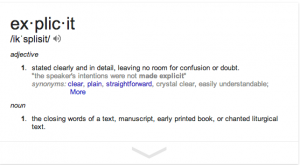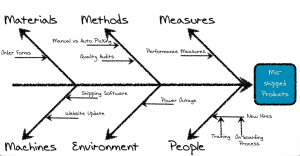“Pam! Call my mom!”
For two weeks I have been miserable. Sneezy. Cough-ey. Stuffy head. It is worse than the man cold. I’ve even gone so far as to post Facebook photos of my medicine arsenal trying to elicit some extra sympathy from my old elementary school friends and random people I met at bars. I even finally went to the walk in clinic – which I never do- and the doctor told me to “get over it sweetheart” and to stop coughing into my hand and into my elbow. No sympathy from that gem.
Whether by the delirium of the flu I’m battling, or the near-fatal cocktail of NyQuil & NeoCitran, I bring to you some amazing parallels between the flu and bad processes in your organization:
1. At first, it just seems like no big deal, or nothing at all.
Was I mouth breathing last night? Is that why my throat hurts? No, I can’t be sick. I just can’t be. It’s so dry in here. I must need a humidifier. I must have sleep apnea. I’m allergic to the dogs! Every single time I get a cold I refuse to believe that it is actually happening to me.
Similarly, organizations often start by telling us that it isn’t their processes that are broken. Staff don’t have the right skill-set. Staff aren’t paid well enough to do their work. Clients don’t understand what they’re doing. The marketplace is changing. This is how we’ve always done it. And nothing has gone wrong…yet.
2. Something suddenly goes very, very bad.
That sore throat is still there. The natural remedies I tried don’t seem to be working. Stuffy nose and stuffy head have arrived on the scene. Things are really bad now and I am scared.
Red alert. A process has gone fully AWOL. You missed a deliverable. The product arrived to the client late. You missed your money back guarantee. You lost the client. The client fired you.
3. Sometimes you cover up the problem so you can pretend its not there.
Once alert mode hits, I start medicating hard and fast, almost as if to ensure I don’t have to experience the cold at all. I run to the drug store and swipe my hand along the cold aisle getting everything I can. Daytime. Night time. Natural. Narc….just kidding. I want to pretend I don’t have a cold. I want to go to the gym, take out the dogs, and carry on business as usual.
In the business world, this happens too. Little bandaid fixes are lurking everywhere. The manager now approves all TPS reports. TPS reports are now approved by the team lead, manager, director, and Senior Director to prevent any and all errors. TPS reports are now exclusively completed by Tom (Tom is apparently very good at these TPS reports and everything he touches. He never makes an error).
4.It always rears its ugly head.
3 days after I’ve self medicated my problem away I forget my Tylenol Cold for Daytime at home while running off to one of my very important meetings with a very important client. By 3pm I am wheezing, coughing, stuffy head, and I can’t think anymore. I tried to make it go away, but the problem was still there lingering behind all the meds.
Despite all those approvals, and Tom’s full time job of spitting out millions of perfect TPS reports, a problem still occurs. Don’t worry, Tom, it wasn’t your fault. The process was still broken, and all the bandaids in the world couldn’t fix it. As Ruth always says, you put a good person in a bad process and the process wins every time! Click to Tweet!
Note: In the real world Tom wins every time – it is quite annoying.
5. It can set you back by days or weeks!
Once the ugliness of the cold comes back. I admit defeat. I let it take its course. I hole up in bed, give everyone around me sad eyes, post sad Facebook statuses, and am generally a pathetic excuse of my former self. I carry on like I’m on my deathbed.
Once the process breaks again, usually folks step back and start to think of other bandaid fixes to ameliorate the problem. Or they stop working on EVERYTHING and start having some high level strategic meetings to find out what is really going on.
6. Sometimes you need a professional, even when you really don’t want one.
Usually after publicizing my illness with those self deprecating Facebook statuses, someone demands that I see a doctor. And I’m so sad at this point that I usually comply. Sometimes they help and sometimes they say “suck it up buttercup”.
Sometimes those strategic meetings end up with a those dreaded fancy consultants in your office working on fixing your processes. And depending on how good they are, sometimes they help and sometimes they don’t.
7. It takes patience to really get to the root cause and get it to go away for good.
Sometimes, you need to go and see your family doctor when things still aren’t getting better. And this takes more time. And patience. But hopefully the right diagnosis.
Your consultants (or maybe your in-house process specialists) have done interviews, current state mapping sessions, root cause analysis, future state mapping sessions, final reports – the whole toolkit comes out. It’s taken time (and money) – but they’ve figured out how to make it work better, faster, and cheaper! And they made it fun too! Oh…they didn’t? I’m sorry. Call us next time.
8. Hindsight is 20/20.
I really should have gotten the flu shot.
We really should have hired those consultants sooner
9. Sometimes you think you are better, but you still need a bit more time.
Really? Four weeks for a cough is normal? Fine I will be patient and rest.
Another small tweak to this process and we’re good to go!
10. When you are better you can go back to saving the world!
A lovely friend of mine responded to my Facebook statuses with: “Quit trying to be a hero, get better, and then go back to saving the world.”
And once you’ve fixed your dreaded process, and Tom’s ego has recovered from the process beating him (just this one time), you and your business can go back to saving the world. Or like Ruth and I, making it better, faster, and cheaper. Tell us about your cold. I can sympathize way better than most. Or tell us about your processes, we actually have a cure for those. Tweet us @whiteboardcons #betterfastercheaper.
I’m going to bed now. I’m still sick. Pout.
Until next time….
Nicole
 Yep, you read that right – ASS “squared”. I’m tired from a busy two weeks after vacation and I’m feeling cheeky. I also met a Canadian guy while on vacation that owned a donkey in Albania named Richard (it’s a long story). It’s my blog and I’ll swear if I want to. I also hate mnemonic sayings that you forget. You will never forget the ASS2
Yep, you read that right – ASS “squared”. I’m tired from a busy two weeks after vacation and I’m feeling cheeky. I also met a Canadian guy while on vacation that owned a donkey in Albania named Richard (it’s a long story). It’s my blog and I’ll swear if I want to. I also hate mnemonic sayings that you forget. You will never forget the ASS2








 Engage people in the development of the process. We love it when we meet with managers who tell us how a process works, and then talk to the people who actually do the work. Usually managers have no idea what really happens. A great way to increase employee engagement is to ask the process users to be part of the documentation and improvement effort. It will make them feel part of the organization, and even address some of the “what’s in it for me” feeling that is deep inside everyone’s work persona.
Engage people in the development of the process. We love it when we meet with managers who tell us how a process works, and then talk to the people who actually do the work. Usually managers have no idea what really happens. A great way to increase employee engagement is to ask the process users to be part of the documentation and improvement effort. It will make them feel part of the organization, and even address some of the “what’s in it for me” feeling that is deep inside everyone’s work persona.








 As we continue along our process improvement journey we focus today on PROVE IT!
As we continue along our process improvement journey we focus today on PROVE IT!


